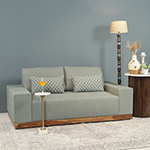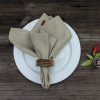Coffee Tables: A Brief History On Your Favorite Furniture Piece
Remember Central Perk, the famous coffee house in the sitcom FRIENDS?
Well, coffee houses turned into cool hangout spots since time immemorial. This fad which began in Britain spread rapidly to the West and now it’s clung to India too. With a number of coffee houses and cafes around the corner, the one thing that actually brought people together apart from the coffee was the one piece of furniture that you hear of every day today.
Yes, we’re talking about the coffee table you have been looking for (if you haven’t got one already).
What began as a fashion fad, i.e. drinking coffee and a pastime at that, caused an increase in the demand for tea and coffee tables. There were pillar and claw tripod tea tables with a round top that were later hinged and were taller than present day coffee tables. Then there were also examples of tea or china tables that were rectangular. Other forms of tables in use at this time which could be placed near to a sofa were called occasional tables, end tables, and what you see in most houses today, center tables.

But let’s cut to the chase and actually tell you about the history of that coffee table of yours. FRIENDS fans, listen up!
Making conversations better since 1750: The history of coffee tables
Dated back to the year of 1750, Britain was witnessing a major spurt in coffee houses and thus the need for coffee tables brought in high backed settees that were later replaced by low back sofas around the 18th century. The sofas were obviously used in conjunction with sofa tables which were designed to stand at the back of the sofa.
It was used to hold a candle stand but often turned to serve the purpose of putting down a book or placing a teacup between sips. All these tables were considered predecessors of the modern day coffee table.

The British East India Company in the 19th century had struck a deal with Canton’s tea merchants when urban ‘coffeehouses’ saw affluent businessmen flocking to them. Whereas, women at home hosted little get-togethers at home called the tea-party as tea was cheap around the tea-table.
It was around the same time, that coffee dethrones tea as America’s favorite beverage when LatAm exporters partnered with savvy local grocers. Coffee companies soon started introducing ‘coffee breaks’ for workers which then entered households, thus putting furniture workers’ to work as they strived to give it an own table.
A famous tale in the normal house setting goes that an English man who was trying to be a good husband to his wife trimmed the legs of a dining table. He named it the ‘coffee table’ for his wife’s impending party that required a centerpiece and he had put his presidency at the Imperial Furniture Company in Grand Rapids, Michigan to good use. The man’s claim to the invention in the early 20th century which could be mere teatime gossip, but Imperial was able to manufacture several ‘coffee tables’ in its lifetime.
Sarah Fayen, assistant curator, Chipstone Foundation, and adjunct assistant curator at the Milwaukee Art Museum offers proof, “Tea tables have existed since the 1720s…Americans used tea tables and coffee tables for countless activities other than imbibing their namesake beverages. The monikers were never intended to prescribe the function of the tables but rather to evoke up-to-date stylish entertaining.”
How the coffee-table fad spread
The first wooden tables, which were specifically designed as coffee tables were made during the late Victorian era in Britain, particularly in the year 1868 when a table designed by E W Godwin was listed as a ‘coffee table’. This categorization of the table as a coffee table, made it to be the first examples in Europe of the modern day much-loved centerpiece.
While other sources, simply list it as a table, hence it’s still unsure; however, the quirky fact about the traditional table is that it was quite high, about 27 inches high.
When coffee tables became increasingly popular in the 20th century, it was not unknown for the table legs, and therefore it had to be shortened to be termed as a ‘coffee table’. The fad has gradually spread and today it has increasingly become an integral piece of furniture that homeowners never miss while decorating their homes.

While coffee tables have a lot of interpretations to its history, it surely has caught the eyesight of many who have brought them to deck up their own space.
Unlike the usually round and tall tea table, the coffee table has seen a massive evolution in design. he design evolution and transformation of these coffee tables through the years have, however, stuck with the design basics.
Any rules for the books on the table?
We say hardly any! Coffee tables serve the purpose of not only placing cups of coffee or tea on them but also to place down magazines and books from your favorite authors.
A light read is always preferable with your legs up on the table while you are cozily sitting on the couch. Books are visual treats and putting together some of your favorite authors and few magazines of different genres can keep you company and also entertain your guests when they visit.
Looking for a coffee table?
Oleg Vintage handpainted coffee table
Wood never disappoints, and hence this mango wood coffee table which has a beautiful white mandala antique design on the top is a different asset to own. It is easy to put a room together with such a centerpiece that has a small deck on the bottom to place some extra stuff.

Pasita wooden coffee table
This Pasita teak wooden coffee table comes in multiple colors which showcase vintage in its look. While one shelf has a transparent opening, it can hold a lot of things inside. On the other hand, the two draws are colored red and green with designs on it. This stunner piece can easily complement any living space.

Devora Coffee table
This table is quirky and can add the ounce of fun to any space. The unique two decks make the table look more like a bar stool. The above deck which is larger the bottom one is beautifully transfixed on an iron like structure that gives it the exclusive design that it has. Buy this Devora coffee table.

Ashley Moroccan Coffee table
This maple colored coffee table is as simple as it looks. Following the basic design concept of traditional coffee tables, the table is short which stands on four legs. However, the uniqueness is on its table top which has a design and has another bottom deck that has parallel gaps in between which can hold books.

Antiquity Blue Coffee table
The antiquity blue coffee table true to its name has a very distinctive design. The curved legs add to the panache of the table and multicolored table top makes it look eccentric. This simple piece of furniture features distinctly due to the subtle mix of colors and the legs. It infuses the traditional coffee table look with a modern day feel which will suit contemporary homes.

Different art movements have inspired the transition in decor pieces used in most homes and the coffee table has also undergone this change. While the influence of these design movements, this utility furniture found its way into homes as center tables. At a befitting time when consumer choice is the king, there exists a wide range of coffee tables to choose from.
As olden designs are being revived, newer styles equally continue to grip the furniture markets, and also your homes.
However, in the end, the choice lies with you because every home deserves a coffee table.



































































239 Comments
iSxvpNUVrquwCM
uYOXtTAIcabjqB
JiIWZOlduUCaQK
EsUjKuQwMV
bdgQSMnkrqyA